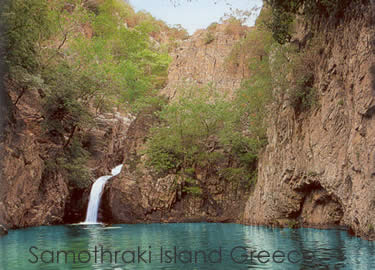 Greek Island of Samothraki (Samothrace)
Greek Island of Samothraki (Samothrace) One of the definite pleasures offered by rugged green island of Samothraki is the approach to it by sea, the peak of Mt. Fengari (Mount Moon) rising 1611 meters (5284 feet) straight up out of the water.
For climbers, the ascent to the top is rewarded by astounding views. The island lies southwest 32 km from the city of Alexandhoupolis in Thrace, on the mainland, and most easily reached from there, though seas are often rough. Except for the coastal area in the north and some rolling hills in the southwest, the island is mountainous; most of its population of 3000, lives in its inland Hora.
Samothraki is not an island to visit in winter, as there is much heavy rain and snow. Most of the tourist accommodation is in the port of Kamariotissa, and is fairly expensive, though the town is unappealing, and the beach rocky, though kaikia (caiques) are available to the good sandy beaches, as well as buses to Hora.
There are limited car and bike rentals, car is the better means of transportation as wind can make the mountain roads dangerous for bikes. The only gas station is between the port and Hora. The latter sits on the slopes of Mt. Fengari in amphitheatrical layout, its houses of the Thracian type - whitewashed stone with red tiled roofs; flowers are everywhere.
There are a few rooms (not all of them advertised), good tavernas on the square, and a good folklore museum (free). The small village of Palaiopolis is to the north of Hora 3 km, mainly visited because it is near the Sanctuary of the Great Gods, with some expensive rooms.
The Sanctuary lasted for at least 1000 years, from around 1000 BC (Late Bronze Age) until Byzantine times, based on a cult focused on the Thracian version Great Mother, the fertility goddess Axieros. The setting is dramatic, flanked by two river torrents. It Mysteries have been compared to those of Elefsis (Eleusis), though it could be visited by anyone, including non initiates.
Most of the ruins are later than the site itself, from Hellenistic and Roman times. There is a museum at the site. The non mountainous plain on the northcoast is a region of streams, waterfalls, hot springs and cultivated land. Loutra (Therma) has three hot bath complexes, two of them free; there are plane trees and fruit trees there, and streams that meet the sea. The town has many cafes and tavernas, though the rooms are pricey, and there are few good eating places.
 At Gria Vathra are waterfalls and rock
pools, not far from the hot baths, and a nice way to cool off after them. There are two municipal campsites on the wooded the coast east of Loutra, the second with more facilities. There are more cold pools and even
better waterfalls at Cape Fonias, and remains of a Genoese watchtower by the sea.
Therma is one of the starting places for a climb up to the peak of Mt. Fengari, the highest peak in the
Aegean islands, with snow on it for nine months of the year, the path beginning from the top of the village
near a big water tank near a big plane tree, though the ascent is easier from Hora, taking about five or six
hours from the latter.
At Gria Vathra are waterfalls and rock
pools, not far from the hot baths, and a nice way to cool off after them. There are two municipal campsites on the wooded the coast east of Loutra, the second with more facilities. There are more cold pools and even
better waterfalls at Cape Fonias, and remains of a Genoese watchtower by the sea.
Therma is one of the starting places for a climb up to the peak of Mt. Fengari, the highest peak in the
Aegean islands, with snow on it for nine months of the year, the path beginning from the top of the village
near a big water tank near a big plane tree, though the ascent is easier from Hora, taking about five or six
hours from the latter.
Some rare indigenous plants live on the mountain. Trails are poorly marked, and it is recommended that hikers tell the owners of the rooms where they are staying that they are ascending the mountain, and start at dawn in order to be down before dark, as army rescue teams have been sent at times to find lost hikers.
On the southwestern part of the island is long Kipos Beach, with fields and rocks behind them for shelter, a shower, spring and summer kantina, though no real tavernas, though en route to the beach the Karydhies Tavernas offers goat dishes from the island's wild goats, home grown vegetables and home baked bread, considered by some to be the best taverna on the island.
South of Hora is the village of Alonia, which is Samothraki's largest, with ruins of Roman baths. The attractive hill village of Profitis Ilias (Prophet Elijah) is located in the fertile south of the island, on bus routes from the port; good tavernas and simple rooms are found there.
The southwest part of the island offers both the nice village of Lakoma and the coarse sand beach of Pakhi Ammos, which has no facilities, but does have a spring, and is accessible also on foot, as are other lovely beaches , including Vatos, where bathing suits are optional. Some visitors enjoy a boat trip around the edges of Samothraki, which is just about the only way to see Kremasto Nero (Hanging Water) waterfall, and the steep south coast, though near the falls is a small beach from which one can walk to the church of Panaghia Kremniotissa (the Precipitous Virgin, roughly), with stunning views.